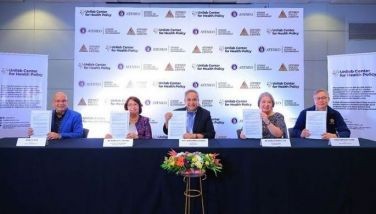Technology developed vs red tide
MANILA, Philippines - Government scientists have developed a new technology to mitigate harmful algal blooms (HABs), commonly known as red tide.
A study conducted by the Department of Science and Technology’s Philippine Council for Aquatic and Marine Research and Development (DOST-PCAMRD) and the University of the Philippines’ Marine Science Institute (UP-MSI) confirmed that a ball made of clay can easily bind together the red tide organisms suspended on the water surface and settle them at the sea bottom where they become inactive.
“Algal cells die when they stick to clay particles,” said Dr. Rhodora Azanza, program leader of PhilHABS and co-project leader for the ball clay technology.
“Clay minerals further entrail the algal cells as they settle at the sea floor,” she said.
The study was conducted under the “Ecology and Oceanography of Harmful Algal Blooms in the Philippines” also known as PhilHABS, a UP-led program supported by the DOST-PCAMRD.
“Clays that are used to mitigate these algal blooms are purely natural,” Azanza said.
She said the efficiency of the ball clay application was tested in actual Pyrodinium bloom in Masinloc Bay, Zambales earlier this year.
“A prototype clay dispersal unit formed the clay balls which were applied on algal blooms. The unit mixes ball clay particles with seawater drawn from the area. Mixing ball clay with seawater will improve the efficiency of ball clay to collide and eventually aggregate with algal cells,” Azanza said.
Azanza’s team found that the cells of Pyrodinium at the surface and bottom of the sea were not present after clay application. The study also showed no negative effects on other marine organisms such as green mussels and milkfish, among others.
During the project’s initial phase, the researchers used 100 kilograms of clay soil from Camarines province for clay application in Zambales and Pangasinan. In the future, clay materials native to affected areas will be used, Azanza said.
The DOST-PCAMRD, through PhilHABs, has been working with the UP-MSI and the National Institute of Geological Sciences as well as the DOST’s Philippine Nuclear Research Institute on different projects to mitigate the occurrence and proliferation of major algal blooms in the tropics.
The PhilHABs is the country’s research and development program on HABs, which contributes to the improvement of the prediction and management of their occurrence through the determination of their ecological and oceanographic conditions. It monitors and manages the occurrence, movement, toxicity, and other environmental effects of algal blooms in different locations within the country.
Azanza said the program has done intensive studies in 10 areas affected by HABs, namely: Manila Bay; Sorsogon Bay, Sorsogon; Bolinao and Anda, Pangasinan; Matarinao Bay, Eastern Samar; Cancabato Bay, Leyte; Murcielagos Bay, Zamboanga del Norte; Balete Bay, Davao Oriental; Pujada Bay, Davao Oriental; and Benoni Lagoon, Camiguin.
The program has forged close collaboration with concerned local government units to enhance community coping mechanisms. Various activities of the program include information dissemination, emergency response, and mapping of causative organisms, and clay dispersal on actual blooms.
Some ongoing mitigating efforts include training and seminars on HABs facilitated by the UP-MSI, culturing of causative organisms for research and development, and PhilHABs’ emergency response including ball clay application on actual blooms, Azanza said.
She said red tide causes economic, public health, and/or environmental harm.
In the Philippines, some 540 outbreaks of harmful algal blooms have been reported since 1983. The most recent outbreaks were in Masinloc Bay, Zambales; Bolinao and Anda, Pangasinan; Murcielagos Bay in Zamboanga del Norte; and Dumanquillas Bay, Zamboanga del Sur, according to Azanza.
The DOST-PCAMRD and UP-MSI will host the third National Harmful Algal Bloom Conference and EAST Asia HAB 7 International meeting this November in Tagbilaran City, Bohol.
The conference will focus on recent developments on HAB research, monitoring, and management, and their implications to the national concerns on harmful algal blooms.
- Latest
- Trending


































